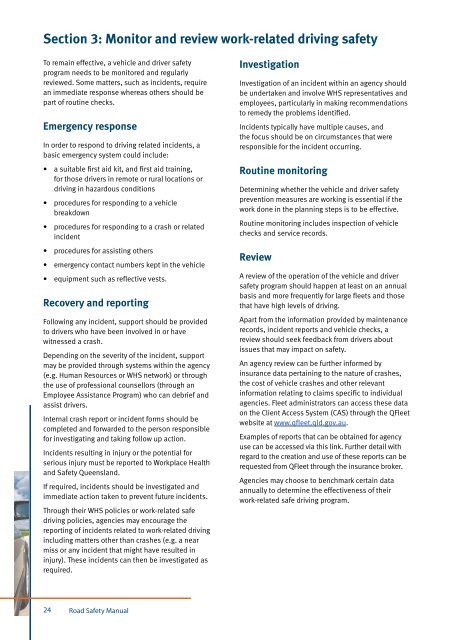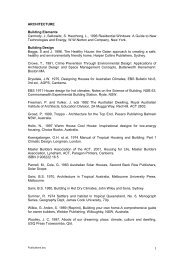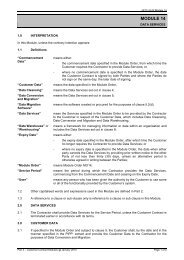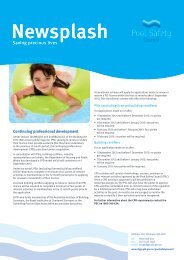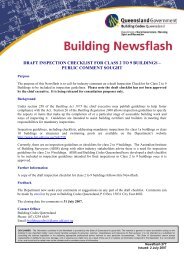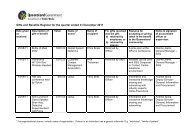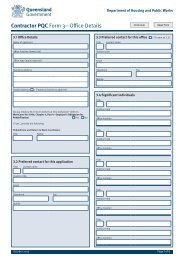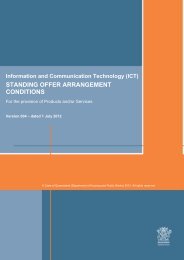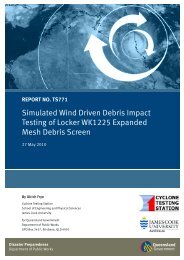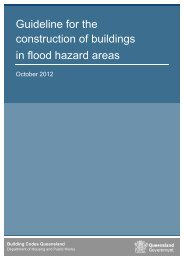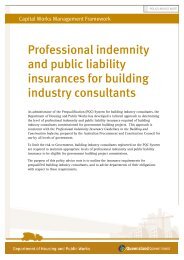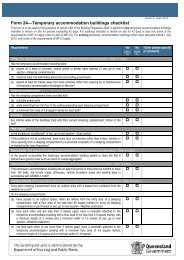QFleet Road Safety Manual - Department of Housing and Public ...
QFleet Road Safety Manual - Department of Housing and Public ...
QFleet Road Safety Manual - Department of Housing and Public ...
Create successful ePaper yourself
Turn your PDF publications into a flip-book with our unique Google optimized e-Paper software.
Section 3: Monitor <strong>and</strong> review work-related driving safety<br />
To remain effective, a vehicle <strong>and</strong> driver safety<br />
program needs to be monitored <strong>and</strong> regularly<br />
reviewed. Some matters, such as incidents, require<br />
an immediate response whereas others should be<br />
part <strong>of</strong> routine checks.<br />
Emergency response<br />
In order to respond to driving related incidents, a<br />
basic emergency system could include:<br />
• a suitable first aid kit, <strong>and</strong> first aid training,<br />
for those drivers in remote or rural locations or<br />
driving in hazardous conditions<br />
• procedures for responding to a vehicle<br />
breakdown<br />
• procedures for responding to a crash or related<br />
incident<br />
• procedures for assisting others<br />
• emergency contact numbers kept in the vehicle<br />
• equipment such as reflective vests.<br />
Recovery <strong>and</strong> reporting<br />
Following any incident, support should be provided<br />
to drivers who have been involved in or have<br />
witnessed a crash.<br />
Depending on the severity <strong>of</strong> the incident, support<br />
may be provided through systems within the agency<br />
(e.g. Human Resources or WHS network) or through<br />
the use <strong>of</strong> pr<strong>of</strong>essional counsellors (through an<br />
Employee Assistance Program) who can debrief <strong>and</strong><br />
assist drivers.<br />
Internal crash report or incident forms should be<br />
completed <strong>and</strong> forwarded to the person responsible<br />
for investigating <strong>and</strong> taking follow up action.<br />
Incidents resulting in injury or the potential for<br />
serious injury must be reported to Workplace Health<br />
<strong>and</strong> <strong>Safety</strong> Queensl<strong>and</strong>.<br />
If required, incidents should be investigated <strong>and</strong><br />
immediate action taken to prevent future incidents.<br />
Through their WHS policies or work-related safe<br />
driving policies, agencies may encourage the<br />
reporting <strong>of</strong> incidents related to work-related driving<br />
including matters other than crashes (e.g. a near<br />
miss or any incident that might have resulted in<br />
injury). These incidents can then be investigated as<br />
required.<br />
Investigation<br />
Investigation <strong>of</strong> an incident within an agency should<br />
be undertaken <strong>and</strong> involve WHS representatives <strong>and</strong><br />
employees, particularly in making recommendations<br />
to remedy the problems identified.<br />
Incidents typically have multiple causes, <strong>and</strong><br />
the focus should be on circumstances that were<br />
responsible for the incident occurring.<br />
Routine monitoring<br />
Determining whether the vehicle <strong>and</strong> driver safety<br />
prevention measures are working is essential if the<br />
work done in the planning steps is to be effective.<br />
Routine monitoring includes inspection <strong>of</strong> vehicle<br />
checks <strong>and</strong> service records.<br />
Review<br />
A review <strong>of</strong> the operation <strong>of</strong> the vehicle <strong>and</strong> driver<br />
safety program should happen at least on an annual<br />
basis <strong>and</strong> more frequently for large fleets <strong>and</strong> those<br />
that have high levels <strong>of</strong> driving.<br />
Apart from the information provided by maintenance<br />
records, incident reports <strong>and</strong> vehicle checks, a<br />
review should seek feedback from drivers about<br />
issues that may impact on safety.<br />
An agency review can be further informed by<br />
insurance data pertaining to the nature <strong>of</strong> crashes,<br />
the cost <strong>of</strong> vehicle crashes <strong>and</strong> other relevant<br />
information relating to claims specific to individual<br />
agencies. Fleet administrators can access these data<br />
on the Client Access System (CAS) through the <strong>QFleet</strong><br />
website at www.qfleet.qld.gov.au.<br />
Examples <strong>of</strong> reports that can be obtained for agency<br />
use can be accessed via this link. Further detail with<br />
regard to the creation <strong>and</strong> use <strong>of</strong> these reports can be<br />
requested from <strong>QFleet</strong> through the insurance broker.<br />
Agencies may choose to benchmark certain data<br />
annually to determine the effectiveness <strong>of</strong> their<br />
work-related safe driving program.<br />
24 <strong>Road</strong> <strong>Safety</strong> <strong>Manual</strong>


